
|
|
Für die deutsche Fassung bitte nach unten scrollen
|
|
Save the Date: Summer Exhibition starting on 9 June in our Showroom in Vienna
|
|
|
Dear friends of ancient art! Due to the current positive development we are able to open our major summer exhibition on 9 June. Under the title "the work that has to be done" we present new acquisitions in museum-quality, amongst them the monumental limestone baboon, who once bestowed inspiration and knowledge to an Egyptian scribe, and the timeless beautiful marble head of a woman of the pudicitia type, who possibly served as a vestal. We exhibit new shabtis as servants for eternity and numerous other ancient statuettes of different cultures, to which significant power has been and is attributed.
|
In parallel the artist Philip Patkowitsch introduces 230 ink drawings of a complete collection of Egyptian shabtis. They represent the interplay between the representational and the abstract, between archaeological drawings and the free play with light and shadow.
|
We are delighted to welcoming you on 9 June for a glass of wine. Opening starts at 7 p.m. Of course it is possible to view the exhibition already from 3 p.m. to allow everybody a relaxing visit.
|
|
|
|
|
|
Our Highlight of the Month:
|
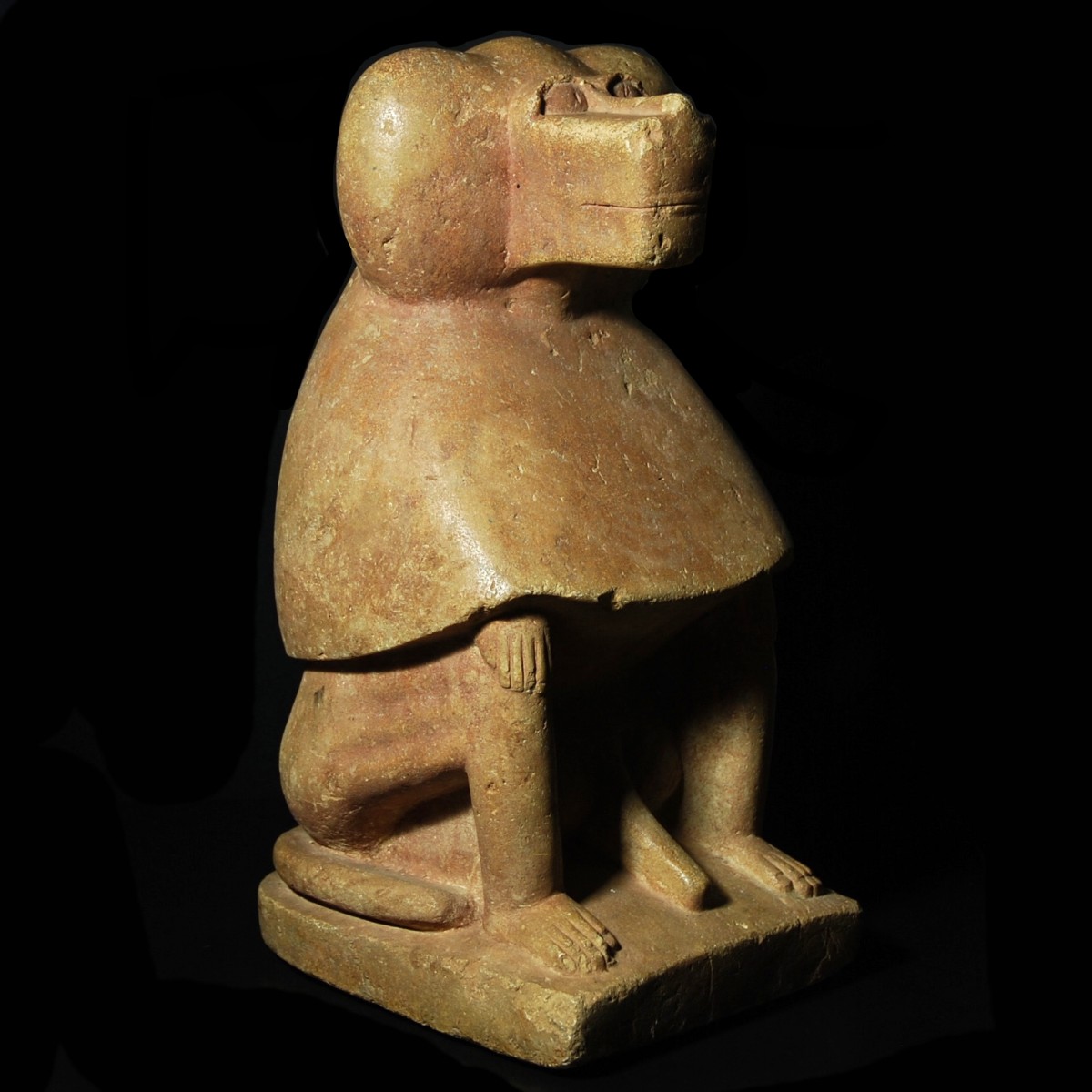
|
|
|
|
|
|
Egypt – New Kingdom, 18th or 19th dynasty, 1540-1186 B.C.
|
Published, monumental statue of a mantle baboon crouching on its plinth. The front paws are supported on the knees and looking out from the cape. The head with a long snout, a sly smile and large, round eyes under thick lids. His long phallus is prominently placed in the middle between the legs. The long tail swung forward around the body to the right foot. With beautiful color remains. Published in: Rupert Wace "Pharaoh’s Creatures: Animals from Ancient Egypt", page 10, July 2004. The baboon is one of the characters of the moon god Thoth, who is also considered the god of knowledge and writing.
|
Provenance: Private collection Paris prior to 1980. Sotheby’s auction New York on 12 July 2001, lot 189. Thence Rupert Wace London. Last in the collection of Claudia Kruber, Florence, Italy. Accompanied by an Italian antiquities passport.
Dimensions: 39.4 cm high
Price: 68 000 Euro
|
|
|
|
Selected Artworks of the Month:
|
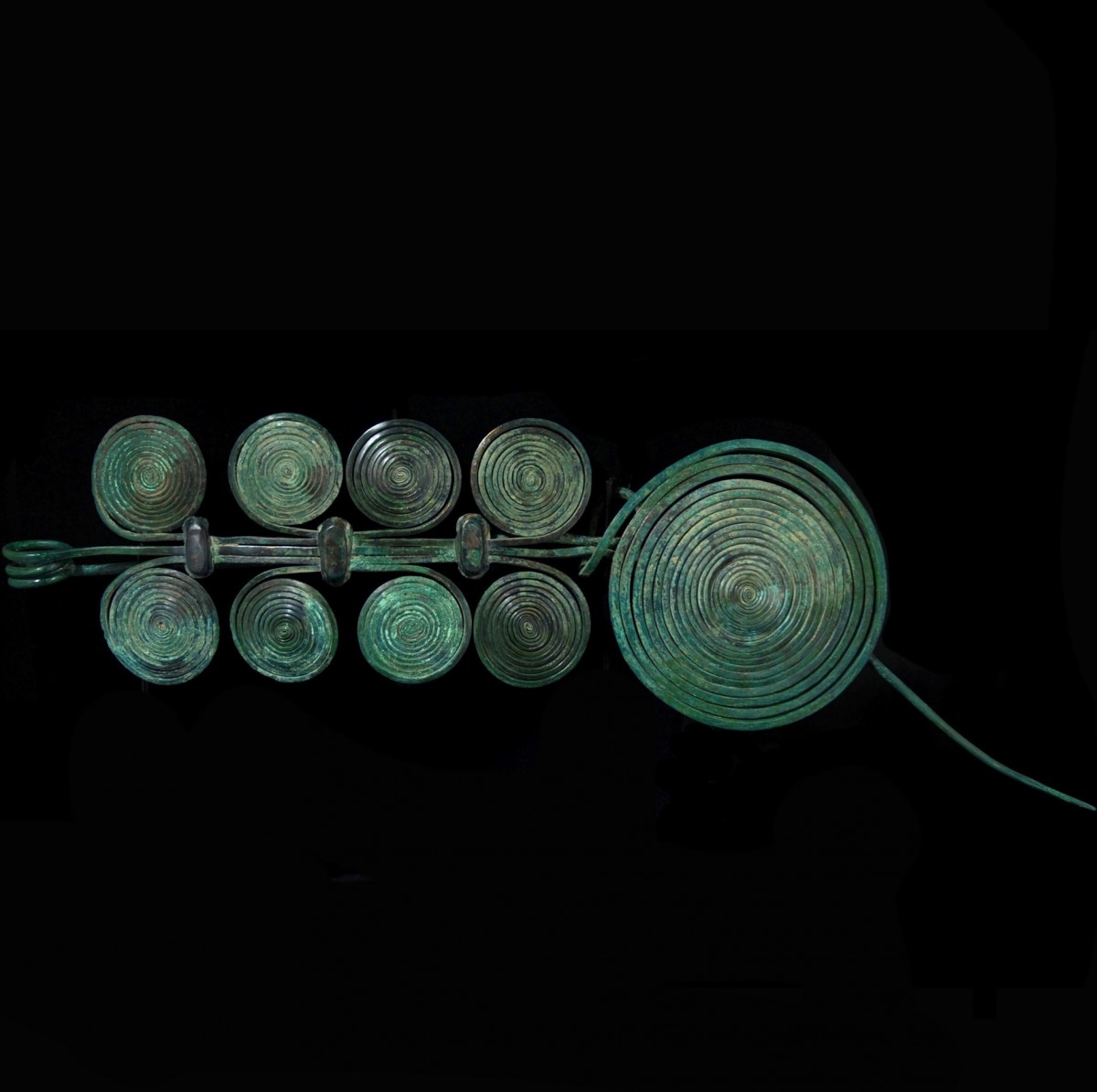
|
|
|
|
Middle Europe – Urnfield period, 11th-10th century B.C.
|
Spectacular and extraordinarily large brooch of the "Posamenterie" type with eight small and one large end spiral, as well as a protruding needle. The large end spiral, the loop as well as the needle are made of a thick bronze wire, which have varying sections. While the wire in the outer coils of the spiral are at first angular, it evolves in the inside of the spiral to a round bronze wire. In the loop it also has a round section. From the small spirals the two outer ones, as well as the two inner ones each form a pair of double spirals made of an angular bronze wire. The elements are connected with three massive claps. The very concise Posamenterie technique seems to have been used in the region of present Slovakia. The brooches were an important part of the festive costume. This specimen is probably one of the largest known to date. Mounted.
|
Provenance: Collection Blaas Vienna, Austria, prior to 1985. Acquired 1985 on the Viennese art market from Dr. S., Graz, Austria. Since then in a family estate.
Dimensions: 38.5 cm long; 49 cm long (including needle)
Price: 18 000 Euro
|
|
|
|
|
|
|
|
|
|
|
Roman Empire – End of 2nd century A.D.
|
High-quality marble head of a young woman in the style of the pudicitia. The face with particularly graceful features, the eyes awake behind thick lids with pierced pupils. Her mouth with its fine lips slightly opened. The woman with parted, thick and wavy hair in the middle, which is held in front by a filet. A veil is pulled over the center of her head framing her face in a circle. The veil is drawn across the entire head in broadly curved folds, and a bulge on the back of the head indicates the hair knot underneath. Under the veil, parts of the ears are still worked out at the front. The pudicitia type stands for decency and modesty, personified by the goddess Pudicitia, to whom two temples in Rome were dedicated. Mounted.
|
Provenance: French private collection V., acquired between 1960 and 1980. With an old collection label at the bottom of the base.
Dimensions: 8 cm high
Price: 8 000 Euro
|
|
|
|

|
|
|
|
Greece/Taranto – around 500 B.C.
|
Expressive antefix with Gorgoneion. The almond-shaped eyes between thick lids, the mouth wide open creating a grotesque face with sharp teeth, the nose long and pointy. Framing the face are two rows of snail curls. On the outside erected snakes with rolled up tails. Beautiful color remains. Possibly from Taranto. Mounted.
|
Provenance: Old Belgian private collection, thence with André Munter Archeologie, Brussels, Belgium. There acquired on 15 November 2002 by another Belgian private collection. Accompanied by an original certificate from André De Munter, Brussels, Belgium. On the back of the certificate a sticker with a stamp of a court inspection dated 26 June 2009 with the signature of the law clerk F. Coene N.
Dimensions: 16.5 cm in diameter
Price: 4 000 Euro
|
|
|
|
|
|
|
|
|
|
|
Egypt – Ptolemaic period, 332-30 B.C.
|
The youthful god undressed in a striding position, the left foot put forward. He typically holds the index finger of his right hand in front of his mouth. On his head he wears the Double Crown of Egypt, flanked by two uraei, on the right the side-lock of youth cascading to his shoulder. The statuette standing on its original plinth with a tenon. During the Ptolemaic period Harpocrates formed together with Serapis and Isis a triad of gods who was especially worshipped in Alexandria. The gesture of placing the index finger to the mouth was not least interpreted by Plutarch as the gesture of silence which was adopted into the 20th century. In fact, it is now assumed that this should only represent the god's childhood because in ancient Egypt other signs were common for silence.
|
Provenance: French private collection acquired prior to 1973. Christie’s auction London on 1 October 2015, lot 163. Last private collection E.W., Vienna, Austria.
Dimensions: 21 cm high
Price: 12 000 Euro
|
|
|
|
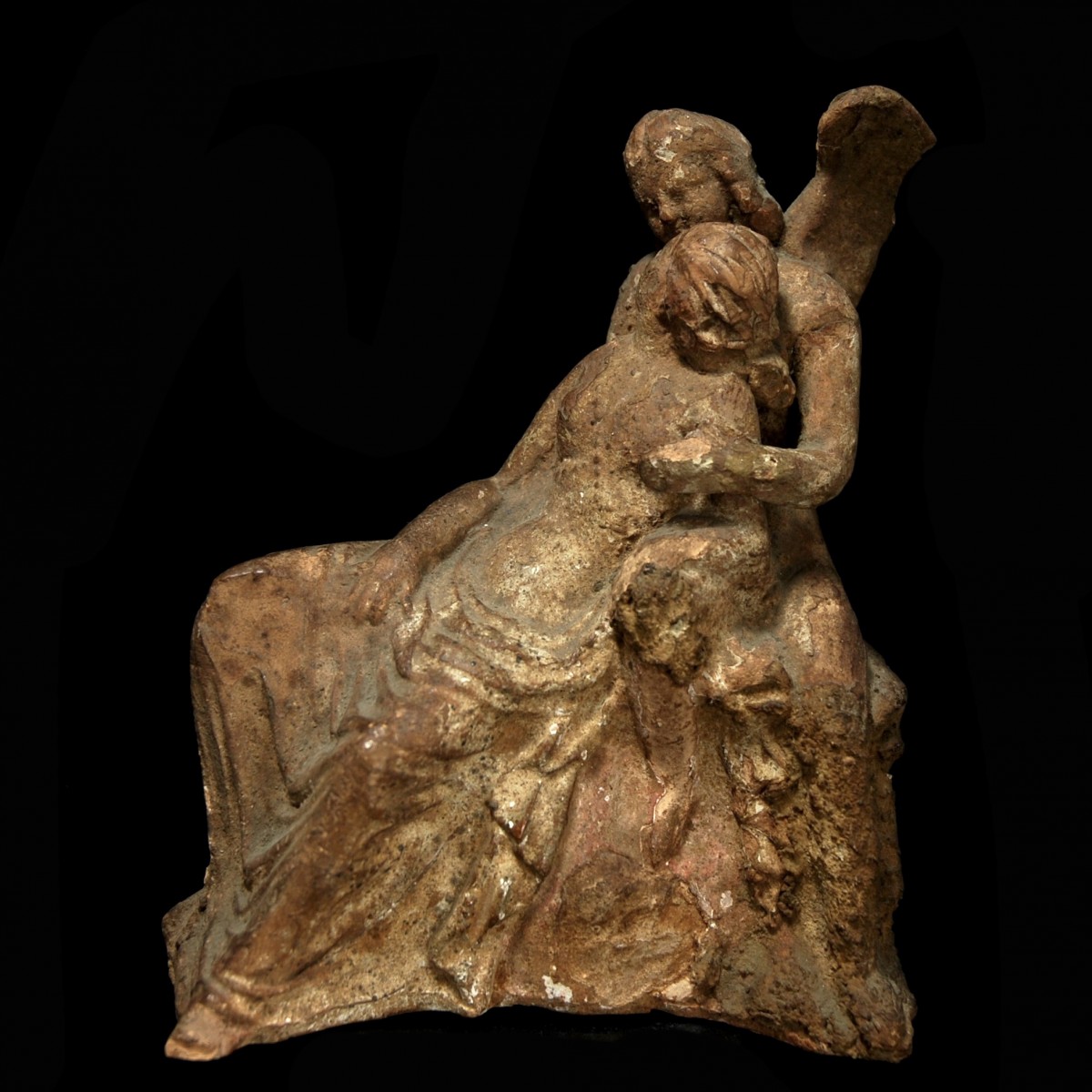
|
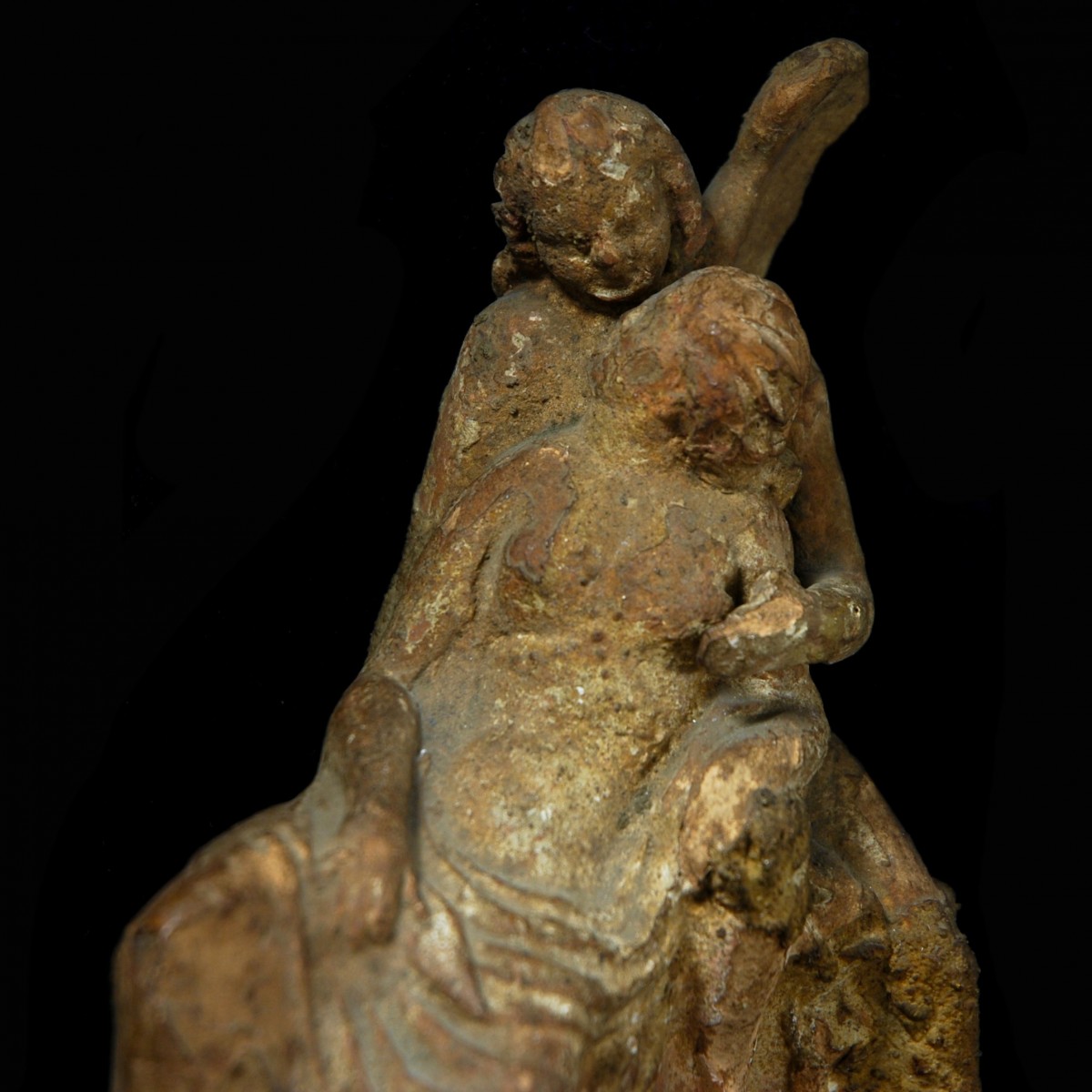
|
|
|
|
Greece/Taranto – 3rd century B.C.
|
Fragment of a terracotta group depicting Cupid and Psyche. The divine Cupid seated on a rock facing lovingly to his beloved and tenderly holding her in his arm. His long hair cascades along the nape. The wings are raised. The mortal Psyche with her hair pulled back and bare upper body leans in his lap and turns her head to her lover. She wears a dress wrapped around her waist and pleating down her lap. The left leg is advanced, the right one leans on a rock. A wonderful terracotta group full of tenderness. Possibly from Taranto. With a TL test of 8 August 2019 confirming the age of the statuette.
|
Provenance: French private collection Charles-Louis Frossard (1827-1902). Through inheritance to daughter Emilie Isabelle Frossard (1854-1921). Thence through inheritance to Henry Schloesing (1879-1958) who sold it in 1928 to Joseph Altounian (1890-1954). Since then in a family estate. Accompanied a French antiquities passport.
Dimensions: 14 cm x 11 cm
Price: 2 800 Euro
|
|
|
|
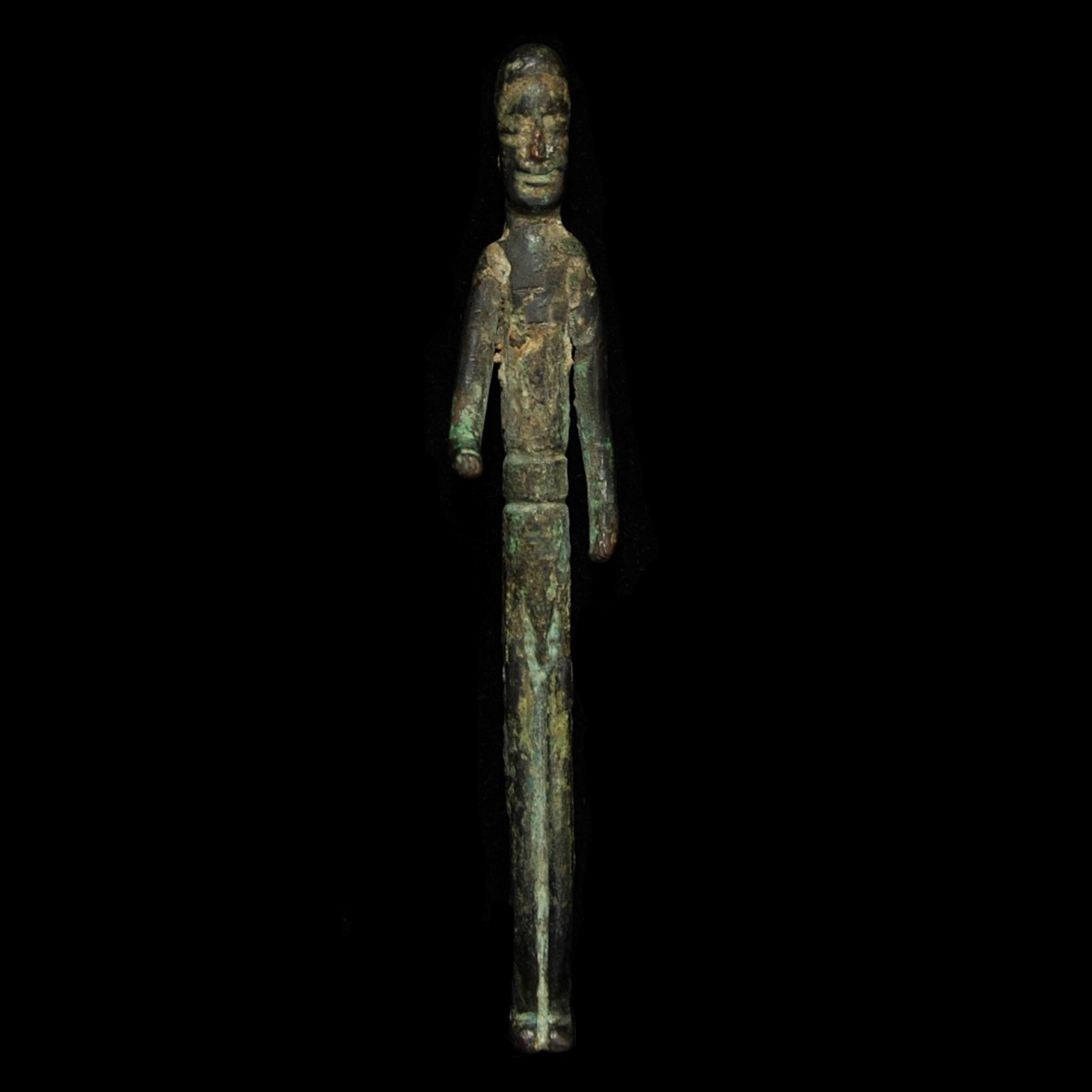
|
|
|
|
|
|
Etruria – 4th-3rd century B.C.
|
Rare, rod-shaped votive figure of a man. Body, head and extremities are stylized elongated. The face with a long nose, large almond-shaped eyes and a mouth formed to a smile. The man is undressed except for a broad belt, and has his right arm bent forward. A small indentation in the hand indicates that there was once a separately worked out votive offering. The left arm hangs slightly angled. The long slender legs are closed, slightly protruding feet are emerging at the bottom. For the type see the world-famous votive statuettes from Volterra in the Villa Giulia in Rome, Italy. The most renowned example of these elongated bronze statuettes, the 57.3 cm high “Ombra della Sera” (Shadow of the evening) is today in the Museo Etrusco Guarnacci in Volterra, Italy. He is considered for many as a model and inspiration for contemporary artist Alberto Giacometti (1901-1966). Mounted.
|
Provenance: From an old German private collection since around 1970.
Dimensions: 16 cm high
Price: 8 000 Euro
|
|
|
|
|
|
|
|
|
Byzantine Empire – 6th century A.D.
|
Large bronze amphora formed from a hammered bronze sheet with a projecting corpus, standing on a set off foot ring. The shoulder sloping with a set off step. On the upper step incised herringbone decoration. The neck tapering towards the top, the mouth widely pulled out, the rim vertical. The handles in the shape of two leopards are worked out separately. The animals sit with their forepaws, worked out in details, on a crescent bronze piece attached horizontally on the mouth. The closed and stylized hind legs sit on a triangular bronze plate with a drop-shaped ending. The animals’ tail is raised and rest on the back. See for the type two bronze amphoras with Christie’s New York, 4 June 2015, lots 27 and 29.
|
Provenance: German private collection in the 1990s. Last in the private collection Claus-Eberhard Schultze, Berlin, Germany.
Dimensions: 40.5 cm high
Price: 8 000 Euro
|
|
|
|
|
|
|
|
|
Luristan – around 800 B.C.
|
Small, stylized bronze head with numerous fine details. The eyes are circular with punched pupils, the nose long and bulbous, the mouth broadly open with thickly fluted teeth. The ring-shaped ears protruding, and possibly once had separately worked out earrings. The hair on the forehead in fringes, pulled up to a towering bun on the head. On the back of the head thick notched strands. Mounted.
|
Provenance: Swiss private collection, acquired at the art market Basel in 2000.
Dimensions: 2.3 cm high
Price: 420 Euro
|
|
|
|
|
|
|
|
|
|
|
Greece – end 5th century B.C.
|
A hollow terracotta statuette of Silenus, formed from a mould. Dionysus’ tutor is here depicted as a drinker and reveller. He crouches nude with a big belly on a rounded basis and holds in his left hand a kantharos. He has thick black hair and a long, curly beard. With intensive red, white and black color remains.
|
Provenance: German private collection 1980s. Thence with Galerie Jürgen Haring in Freiburg im Breisgau, Germany. Last at the Swiss art market.
Dimensions: 9 cm high
Price: 800 Euro
|
|
|
|
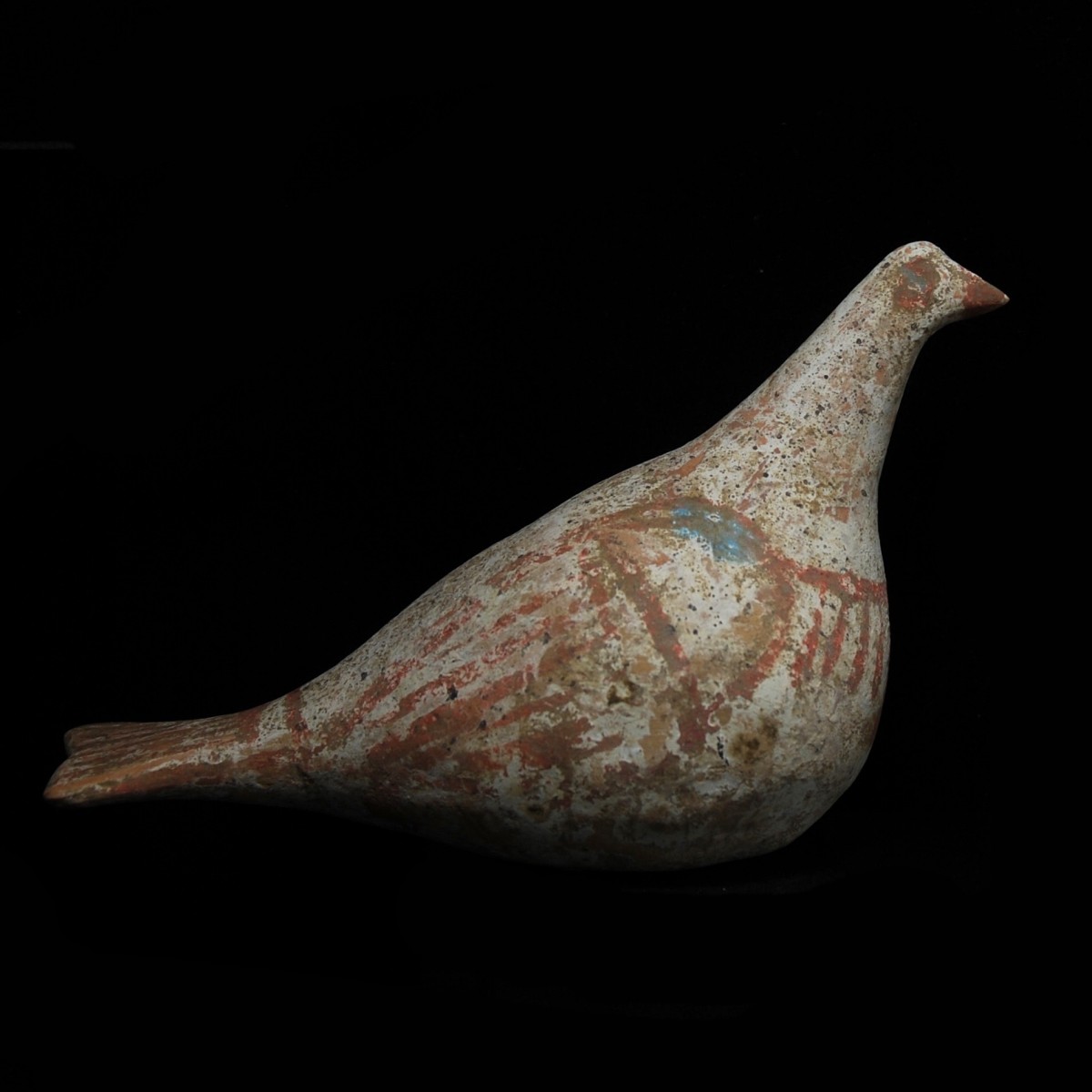
|
|
|
|
Greece/Canosa – Late 4th to early 3rd century B.C.
|
Massive, hand formed terracotta dove with beautifully preserved painting, typical for the Apulian Canosa. After the firing the details of the feathers and eyes were applied in red and blue colour on the white primer. The head is small and raised, the wings are resting on the body and the tail horizontally protruding. A small perforation at the bottom indicates that the dove, with the help of a wood stick, originally served as a sculptural decoration of a vase. For the type of dove see the Leo Mildenberg collection, published in “Tierbilder aus vier Jahrtausenden. Antiken der Sammlung Mildenberg”, number 152, page 160.
|
Provenance: Old Belgian private collection. Thence with André Munter Archeologie, Brussels, Belgium. There acquired on 30 October 2005 by another Belgian private collection. Accompanied by an original certificate from André De Munter, Brussels, Belgium. On the back of the certificate a sticker with a stamp of a court inspection dated 26 June 2009 with the signature of the law clerk F. Coene N.
Dimensions: 16.8 cm long
Price: 900 Euro
|
|
|
|
|
|
A Collection of Stone Age Hand Axes from the Estate of Wilfriede and Leopold Tamm, Langenzersdorf, Austria.
Acquired in the 1970s:
|
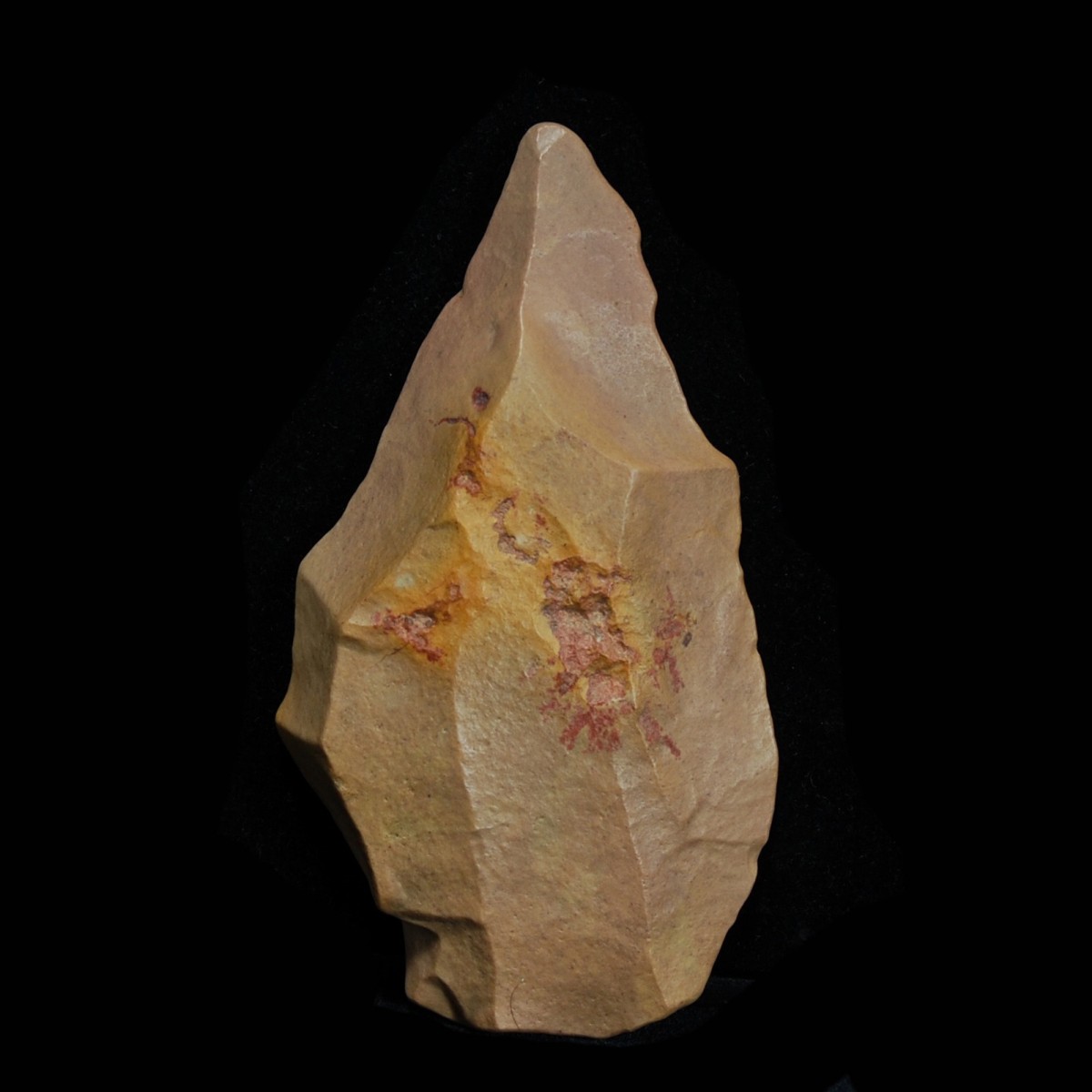
|
|
North Africa/Libya – 400,000-50,000 B.C.
|
|
Flat hand axe of clear flintstone worked out on both sides. The edges are all sharpened to cut plants or meat. The tapering end was used as a drill. One side is completely flat. Found in Libya.
|
Dimensions: 11.8 cm x 6.6 cm
Price: 200 Euro
|
|

|
|
North Africa/Libya – 800,000-300,000 B.C.
|
|
Small hand axe of red-brown flintstone worked out on both sides. The edges are all sharpened to cut plants or meat. The tapering end was used as a drill. Found in Libya.
|
Dimensions: 9 cm x 5 cm
Price: 150 Euro
|
|
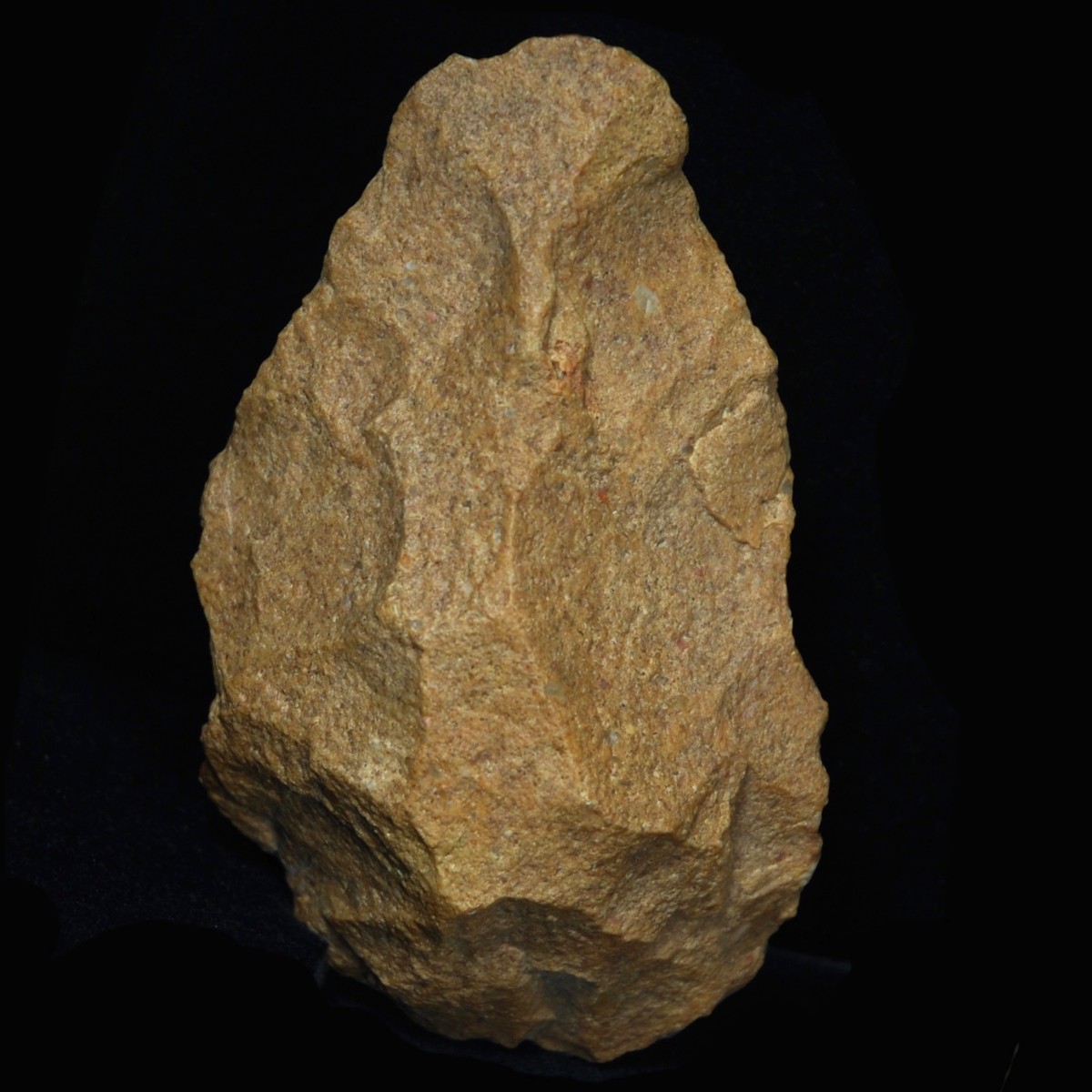
|
|
North Africa/Libya – 400,000-50,000 B.C.
|
|
Massive hand axe of quartzite sandstone worked out on both sides. The edges are all sharpened to cut plants or meat. The tapering end was used as a drill. With beautiful desert patina. Found in Libya.
|
Dimensions: 11.2 cm x 7 cm
Price: 180 Euro
|
|
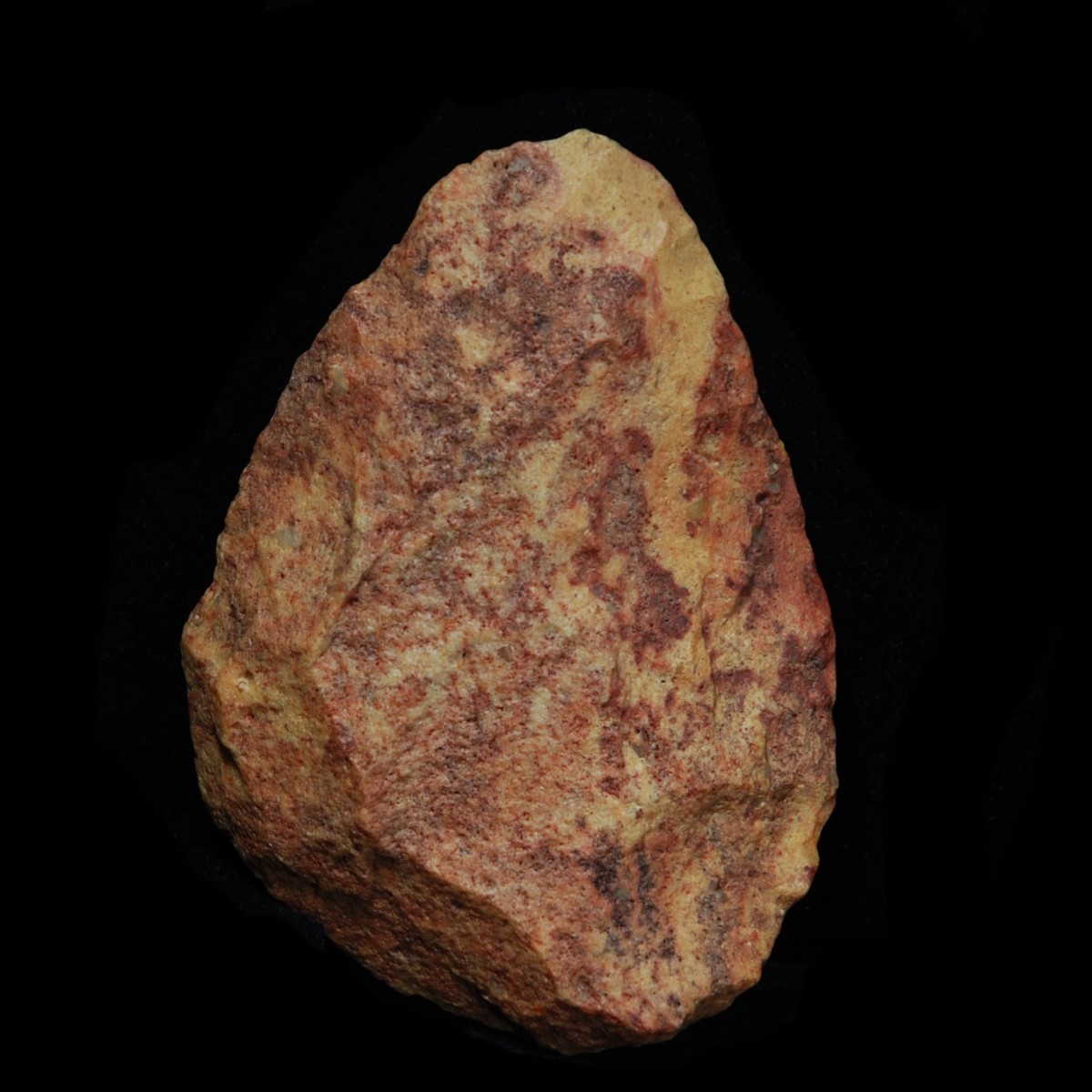
|
|
North Africa/Libya – 400,000-50,000 B.C.
|
|
Hand axe of colorful quartzite worked out on both sides. The edges are all sharpened to cut plants or meat. The tapering end was used as a drill. With beautiful desert patina. Found in Libya.
|
Dimensions: 10.2 cm x 7.8 cm
Price: 180 Euro
|
|
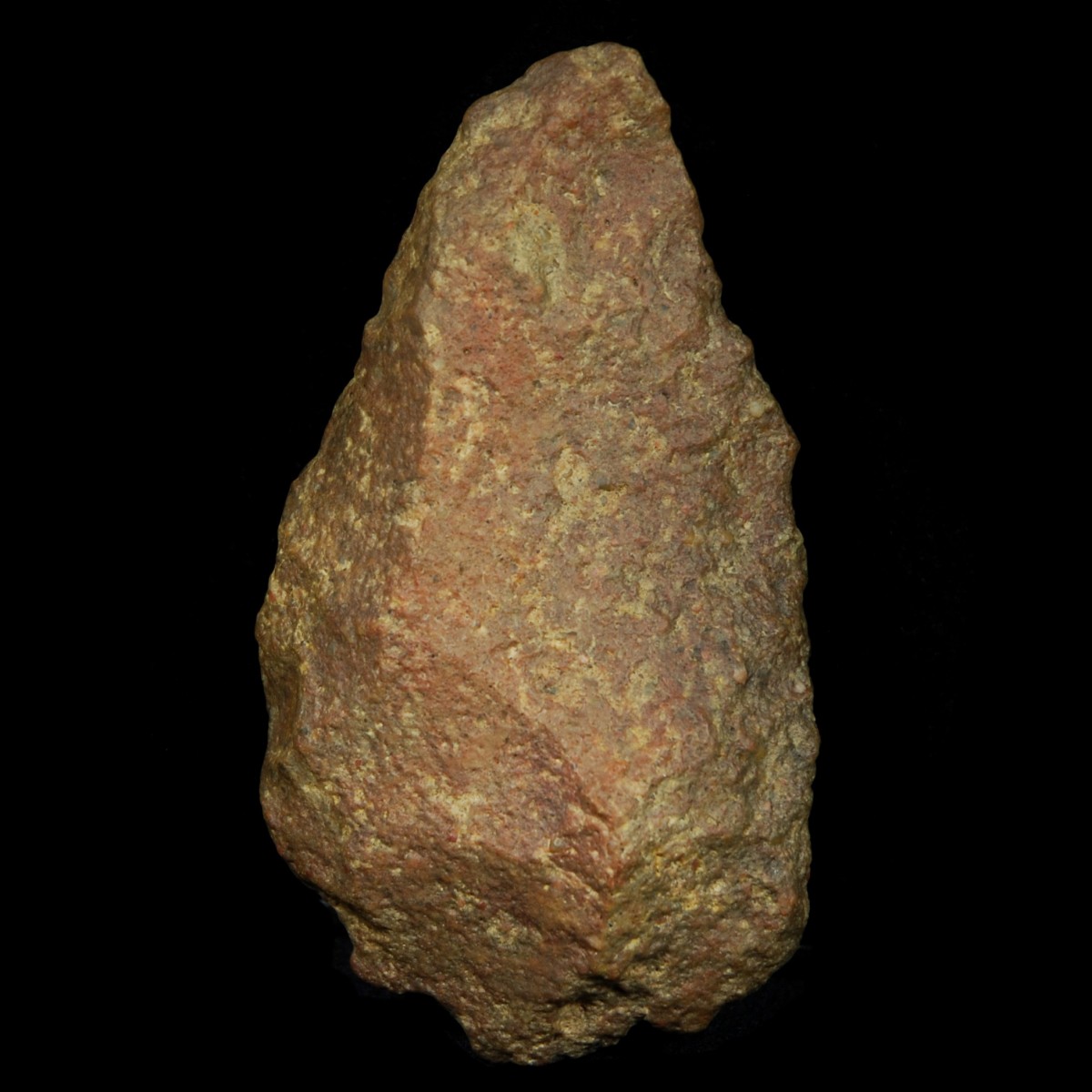
|
|
North Africa/Libya – 800,000-300,000 B.C.
|
Massive and heavy hand axe of quartzite sandstone worked out on both sides. The edges are all sharpened to cut plants or meat. The tapering end was used as a drill. With beautiful desert patina. Found in Libya.
|
Dimensions: 11.8 cm x 6.5 cm
Price: 180 Euro
|
|
|
|
|
|
Save the Date: Sommer-Ausstellung ab
9. Juni in unserem Showroom in Wien
|
Liebe Freunde antiker Kunst! Aufgrund der aktuellen, positiven Entwicklungen ist es uns möglich, am 9. Juni unsere große Sommer-Ausstellung zu eröffnen. Unter dem Titel "the work that has to be done" zeigen wir museale Neuerwerbungen, darunter den monumentalen Kalkstein-Pavian, der einem ägyptischen Schreiber einst Inspiration und Wissen schenkte und den zeitlos schönen Marmorkopf einer Frau im Pudicitia-Typus, die möglicherweise einst als Vestalin Dienst versah. Wir präsentieren neue Uschebtis als Diener für die Ewigkeit und zahlreiche weitere antike Statuetten verschiedenster Kulturen, denen bedeutende Macht zugeschrieben wurde und wird.
Gleichzeitig stellt der Künstler Philip Patkowitsch 230 Tusche-Zeichnungen einer kompletten Sammlung ägyptischer Uschebtis vor. Sie bewegen sich im Spannungsfeld zwischen gegenständlichem und abstraktem, zwischen Archäologie-Zeichnungen und dem freien Spiel mit Licht und Schatten.
|
Wir freuen uns, Sie am 9. Juni auf ein Glas Wein begrüßen zu dürfen. Eröffnung ist um 19.00 Uhr. Selbstverständlich wird es aber möglich sein, schon ab 15.00 die Ausstellung zu besichtigen, um für alle einen entspannten Besuch zu ermöglichen.
|
|
|
|
Unser Highlight des Monats:
|
|
Ägypten – Neues Reich, 18. oder 19. Dynastie, 1540-1186 v. Chr.
|
Publizierte, monumentale Statue eines Mantelpavians, der auf seiner mitgearbeiteten Plinthe hockt. Die Vorderpfoten sind auf den Knieen abgestützt und schauen unter dem Umhang hervor. Der Kopf mit langer Schnauze, verschmitztem Lächeln und großen, runden Augen unter dicken Lidern. Zwischen den Beinen ist sein langer Phallus prominent in der Mitte platziert. Der lange Schwanz nach vorne um den Körper bis zum rechten Fuß geschwungen. Mit schönen Farbresten. Publiziert in: Rupert Wace „Pharaoh’s Creatures: Animals from Ancient Egypt“, Seite 10, Juli 2004. Der Pavian gilt als eine der Gestalten des Mondgottes Thot, der auch als Gott des Wissens und des Schreibens gilt.
|
Provenienz: Privatsammlung Paris vor 1980. Sothebys Auktion New York vom 12. Juni 2001, Los 189. Danach Rupert Wace London. Zuletzt in der Sammlung von Claudia Kruber, Florenz, Italien. Mit italienischem Antikenpass.
Höhe: 39,4 cm
Preis: 68.000 Euro
|
|
|
|
Ausgewählte Kunstwerke des Monats:
|
|
Mitteleuropa – Urnenfelderzeit, 11.-10. Jahrhundert v. Chr.
|
Spektakuläre und ungewöhnlich große Posamentierfibel mit acht kleinen und einer großen Endspirale sowie einer weit abstehenden Nadel. Die große Endspirale, die Nadelkehr (Schlaufe) sowie die Nadel sind aus einem dicken Bronzedraht gefertigt, der einen wechselnden Querschnitt aufweist. Während der Draht in den Außenwindungen der Spirale zunächst eckig ist, entwickelt er sich im Inneren der Spirale zu einem runden Bronzedraht. Auch in der Nadelkehr weist er einen runden Querschnitt auf. Von den kleinen Spiralen bilden die jeweils äußeren sowie die beiden inneren je ein Paar Doppelspiralen, die jeweils aus einem eckigen Bronzedraht gefertigt sind. Verbunden sind die Elemente durch drei massive Klammern. Diese äußerst präzise Posamenterietechnik scheint im Gebiet der heutigen Slowakei entwickelt worden zu sein. Die Fibeln bildeten einen bedeutenden Bestandteil der Prunktracht. Dieses Exemplar ist wohl eines der größten bisher bekannten. Gesockelt.
|
Provenienz: Sammlung Blaas Wien vor 1985. Erworben 1985 am Wiener Kunstmarkt von Dr. S., Graz. Seitdem in Familienbesitz.
Dimensionen: Länge 38,5 cm; Länge inklusive Nadel 49 cm.
Preis: 18.000 Euro
|
|
|
|
|
Römisches Reich – Ende 2. Jahrhundert n. Chr.
|
Hochwertig gearbeitetes Marmor-Köpfchen einer jungen Frau im Stil der Pudicitia. Das Gesicht mit besonders anmutigen Zügen, die Augen wach hinter dicken Lidern mit gelochter Pupille. Der Mund mit seinen feinen Lippen leicht geöffnet. Die Frau mit in der Mitte gescheiteltem, dichtem und welligem Haar, das vorne von einem Haarband gehalten wird. Über die Kopfmitte hat sie einen Schleier gezogen, der ihr Gesicht kreisförmig einrahmt. Der Schleier ist in breit geschwungenen Falten über den kompletten Kopf gezogen, am Hinterkopf weist eine Ausbeulung auf den darunter liegenden Haarknoten hin. Unter dem Schleier sind vorne noch Teile der Ohren ausgearbeitet. Der Pudicitia-Typus steht für die Schamhaftigkeit und Bescheidenheit, personifiziert durch die Göttin Pudicitia, der zwei Tempel in Rom geweiht waren. Gesockelt.
|
Provenienz: Französische Privatsammlung V., erworben zwischen 1960 und 1980. Mit einem alten Sammlungsetikett auf der Unterseite des Sockels.
Höhe: 8 cm
Preis: 8.000 Euro
|
|
|
|
|
Griechenland/Tarent – um 500 v. Chr.
|
Expressives Antefix mit Gorgoneion. Die mandelförmigen Augen zwischen dicken Lidern, der weit zur Fratze aufgerissene Mund mit scharfen Zähnen, die Nase lang und spitz. Um das Gesicht zwei Reihen kleiner Schneckenlocken. Außen herum aufgerichtete Schlangen mit eingerollten Schwänzen. Schöne Farbreste. Wohl aus Tarent. Gesockelt.
|
Provenienz: Alte belgische Privatsammlung, danach André Munter Archeologie, Brüssel. Dort erworben am 15. November 2002 von einer anderen belgischen Sammlung. Mit Original-Zertifikat von André De Munter Archéologie, Brüssel. Auf der Rückseite des Zertifikats ein Aufkleber mit Stempel einer Gerichtsbeschau vom 26. Juni 2009 mit der Unterschrift des Gerichtsschreibers F. Coene N.
Durchmesser: 16,5 cm
Preis: 4.000 Euro
|
|
|
|
|
Ägypten – 26. Dynastie, Regierungszeit des Amasis II., 570-526 v. Chr.
|
Der unbekleidete jugendliche Gott in schreitender Position, den linken Fuß vorangesetzt. Den Zeigefinger der rechten Hand hält er typisch vor den Mund. Am Kopf trägt er die Doppelkrone Ägyptens, flankiert von zwei Uraei, rechts hängt ihm die jugendliche Haarlocke bis zur Schulter. Die Statuette steht noch auf ihrer Original-Plinthe mit Zapfen. Mit Serapis und Isis bildete Harpokrates in ptolemäischer Zeit eine Göttertriade, die vor allem in Alexandria verehrt wurde. Die Geste des Zeigefingers am Mund wurde nicht zuletzt von Plutarch als Geste des Schweigens gedeutet und bis in das 20. Jahrhundert hinein übernommen. Tatsächlich geht man inzwischen davon aus, dass damit nur das Kindsein des Gottes dargestellt werden sollte, weil im Alten Ägypten für Schweigen andere Zeichen üblich waren.
|
Provenienz: Französische Privatsammlung erworben vor 1973. Christie’s Auktion London vom 1. Oktober 2015, Los 163. Zuletzt Privatsammlung E. W., Wien.
Höhe: 21 cm
Preis: 12.000 Euro
|
|
|
|
|
Griechenland/Tarent – 3. Jahrhundert v. Chr.
|
Fragment einer Terrakotta-Gruppe, die Amor und Psyche darstellt. Der göttliche Amor auf einem Felsen sitzend hat den Kopf liebevoll der Angebeteten zugewandt und hält sie zärtlich im Arm. Sein langes Haar fällt ihm hinten in den Nacken. Die Flügel sind aufgerichtet. Die sterbliche Psyche mit zurückgebundenen Haaren und entblößtem Oberkörper lehnt in seinem Schoß und hat ihren Kopf dem Geliebten zugewandt. Sie trägt ein Kleid um die Hüften geschlungen, das ihr faltenreich über den Schoß hinab fällt. Das linke Bein ist nach vorne gestreckt, das rechte am Felsen abgestützt. Eine herrliche Terrakotta-Gruppe voll Zärtlichkeit. Wohl aus Tarent. Mit TL-Test vom 8. August 2019, der das Alter der Statuette bestätigt.
|
Provenienz: Französische Privatsammlung Charles-Louis Frossard (1827-1902). Durch Erbe an die Tochter Emilie Isabelle Frossard (1854-1921). Durch Erbe an Henry Schloesing (1879-1958). Von diesem 1928 verkauft an Joseph Altounian (1890-1954). Seitdem in Familienbesitz. Mit französischem Antikenpass.
Dimensionen: 14 cm x 11 cm
Preis: 2.800 Euro
|
|
|
|
|
Etrurien – 4.-3. Jahrhundert v. Chr.
|
Seltene, stabförmige Votivfigur eines Mannes. Körper, Kopf und Gliedmaßen sind stilisiert in die Länge gezogen. Das Gesicht mit langer Nase, großen mandelförmigen Augen und einem zu einem breiten Lächeln geformten Mund. Der Mann ist abgesehen von einem breiten Gürtel unbekleidet und hat seinen rechten Arm abgewinkelt nach vorne gestreckt. Eine kleine Vertiefung in der Hand weist daraufhin, dass hier einst eine separat gefertigte Votivgabe lag. Der linke Arm hängt leicht abgewinkelt herab. Die langen schlanken Beine sind anliegend, unten zeichnen sich, leicht hervorstehend, die Füße ab. Vergleiche zum Typus die weltberühmten Votiv-Statuetten aus Volterra in der Villa Giulia in Rom. Das berühmteste Beispiel dieser langgezogenen Bronze-Statuetten, der 57,3 cm hohe „Ombra della Sera“ (Abendschatten) befindet sich heute im Museo Etrusco Guarnacci in Volterra, Italien. Er gilt vielen als Vorlage und Inspiration des zeitgenössischen Künstlers Alberto Giacometti (1901 – 1966). Gesockelt.
|
Provenienz: Aus alter deutscher Privatsammlung seit etwa 1970.
Höhe: 16 cm
Preis: 8.000 Euro
|
|
|
|
|
Byzantinisches Reich – 6. Jahrhundert n. Chr.
|
Aus gehämmertem Bronzeblech geformte, große Bronze-Amphora mit weit ausladendem Korpus, der auf einem abgesetzten Standring steht. Die Schulter abgeschrägt mit abgesetzter Stufe. Auf der oberen Stufe eingeprägtes Fischgrätmuster. Der Hals nach oben hin schmäler werdend, die Mündung weit nach außen gezogen, der Rand vertikal. Die Henkel in Form von zwei Leoparden sind separat gegossen. Die Tiere sitzen mit ihren detailliert ausgearbeiteten Vorderpfoten auf einem sichelförmigen, an die Mündung horizontal genieteten Bronzestück auf. Die anliegenden und stilisierten Hinterbeine sitzen auf einer dreieckigen Bronzeplatte mit tropfenförmigem Abschluss auf. Der Schwanz der Tiere ist aufgerichtet und liegt am Rücken an. Vergleiche zum Typus zwei Bronze-Amphoren bei Christie’s New York, 4. Juni 2015, Los 27 und 29.
|
Provenienz: Deutscher Privatsammlung 1990er Jahre. Zuletzt in der Privatsammlung Claus-Eberhard Schultze, Berlin.
Höhe: 40,5 cm
Preis: 8.000 Euro
|
|
|
|
|
Luristan – um 800 v. Chr.
|
Kleines, stilisiertes Bronze-Köpfchen mit zahlreichen feinen Details. Die Augen kreisförmig mit punzierter Pupille, die Nase lang und knollig, der Mund breit geöffnet mit dick gerillten Zähnen. Die Ohren stehen ringförmig ab und trugen wohl einst separat gearbeitete Ohrringe. Die Haare in der Stirn in Fransen, sind am Kopf zu einem hoch aufragenden Knoten gebunden. Am Hinterkopf dick gekerbte Strähnen. Gesockelt.
|
Provenienz: Schweizer Privatsammlung, erworben am Kunstmarkt Basel im Jahr 2000.
Höhe: 2,3 cm
Preis: 420 Euro
|
|
|
|
|
Griechenland – Ende 5. Jahrhundert v. Chr.
|
Aus der Form gearbeitete, hohle Terrakotta-Statuette des Silen. Der Lehrer des Dionysos ist hier als Trinker und Zecher dargestellt. Er hockt nackt mit großem Wamst auf einer abgerundeten Basis und hält in seiner linken Hand einen Kantharos. Er hat dichtes schwarzes Haar und einen langen, gelockten Bart. Mit intensiven roten, weißen und schwarzen Farbresten.
|
Provenienz: Deutsche Privatsammlung 1980er Jahre. Danach bei Galerie Jürgen Haring in Freiburg im Breisgau. Zuletzt am Schweizer Kunstmarkt.
Höhe: 9 cm
Preis: 800 Euro
|
|
|
|
|
Griechenland/Canosa – Spätes 4. bis frühes 3. Jahrhundert v. Chr.
|
Massive gearbeitete, handgeformte Taube aus Terrakotta mit wunderbar erhaltener Bemalung, wie sie für das apulische Canosa typisch ist. Auf weißer Grundierung wurden die Details der Federn und Augen in roter und blauer Farbe nach dem Brand aufgetragen. Der Kopf ist klein und aufgerichtet, die Flügel sind angelegt und der Schwanz horizontal abstehend. Eine kleine Lochung auf der Unterseite zeigt an, dass die Taube ursprünglich mit Hilfe eines Holzpflockes als plastischer Dekor einer Vase diente. Vergleiche zum Typus die Taube aus der Sammlung Leo Mildenberg, publiziert in „Tierbilder aus vier Jahrtausenden. Antiken der Sammlung Mildenberg“., Nummer 152, Seite 160.
|
Provenienz: Alte belgische Privatsammung, danach André Munter Archeologie, Brüssel. Dort erworben am 30. Oktober 2005 von einer anderen belgischen Sammlung. Mit Original-Zertifikat von André De Munter Archéologie, Brüssel. Auf der Rückseite des Zertifikats ein Aufkleber mit Stempel einer Gerichtsbeschau vom 26. Juni 2009 mit der Unterschrift des Gerichtsschreibers F. Coene N.
Länge: 16,8 cm
Preis: 800 Euro
|
|
|
|
Eine Sammlung steinzeitlicher Faustkeile aus dem Nachlass von Wilfriede und Leopold Tamm, Langenzersdorf, Österreich.
Erworben in den 1970er Jahren:
|
|
|
|
Nordafrika/Libyen – 400.000 – 50.000 v. Chr.
|
|
Beidseitig gearbeiteter, flacher Faustkeil aus hellem Feuerstein. Die Kanten sind umlaufend geschärft, um damit Pflanzen zu schneiden oder Fleisch zu zerteilen. Das spitz zulaufende Ende wurde als Bohrer verwendet. Eine Seite komplett abgeflacht. Gefunden in Libyen.
|
Dimensionen: 11,8 cm x 6,6 cm
Preis: 200 Euro
|
|
|
Nordafrika/Libyen – 800.000 – 300.000 v. Chr.
|
Beidseitig gearbeiteter, kleiner Faustkeil aus rötlich-braunem Feuerstein. Die Kanten sind seitlich geschärft, um damit Pflanzen zu schneiden oder Fleisch zu zerteilen. Das spitz zulaufende Ende wurde als Bohrer verwendet. Gefunden in Libyen.
|
Dimensionen: 9 cm x 5 cm
Preis: 150 Euro
|
|
|
Nordafrika/Libyen – 400.000 – 50.000 v. Chr.
|
Beidseitig gearbeiteter, massiver Faustkeil aus quarzitischem Sandstein. Die Kanten sind umlaufend geschärft, um damit Pflanzen zu schneiden oder Fleisch zu zerteilen. Das spitz zulaufende Ende wurde als Bohrer verwendet. Mit schöner Wüstenpatina. Gefunden in Libyen.
|
Dimensionen: 11,2 cm x 7 cm
Preis: 180 Euro
|
|
|
Nordafrika/Libyen – 800.000 – 300.000 v. Chr.
|
Beidseitig gearbeiteter Faustkeil aus farblich reich durchzogenem Quarzit. Die Kanten sind umlaufend geschärft, um damit Pflanzen zu schneiden oder Fleisch zu zerteilen. Das spitz zulaufende Ende wurde als Bohrer verwendet. Mit schöner Wüstenpatina. Gefunden in Libyen.
|
Dimensionen: 10,2 cm x 7,8 cm
Preis: 180 Euro
|
|
|
Nordafrika/Libyen – 800.000 – 300.000 v. Chr.
|
Beidseitig gearbeiteter, massiver und schwerer Faustkeil aus quarzitischem Sandstein. Die Kanten sind umlaufend geschärft, um damit Pflanzen zu schneiden oder Fleisch zu zerteilen. Das spitz zulaufende Ende wurde als Bohrer verwendet. Mit schöner Wüstenpatina. Gefunden in Libyen.
|
Dimensionen: 11,8 cm x 6,5 cm
Preis: 180 Euro
|
|
|
|
|
|
|
|
|
|
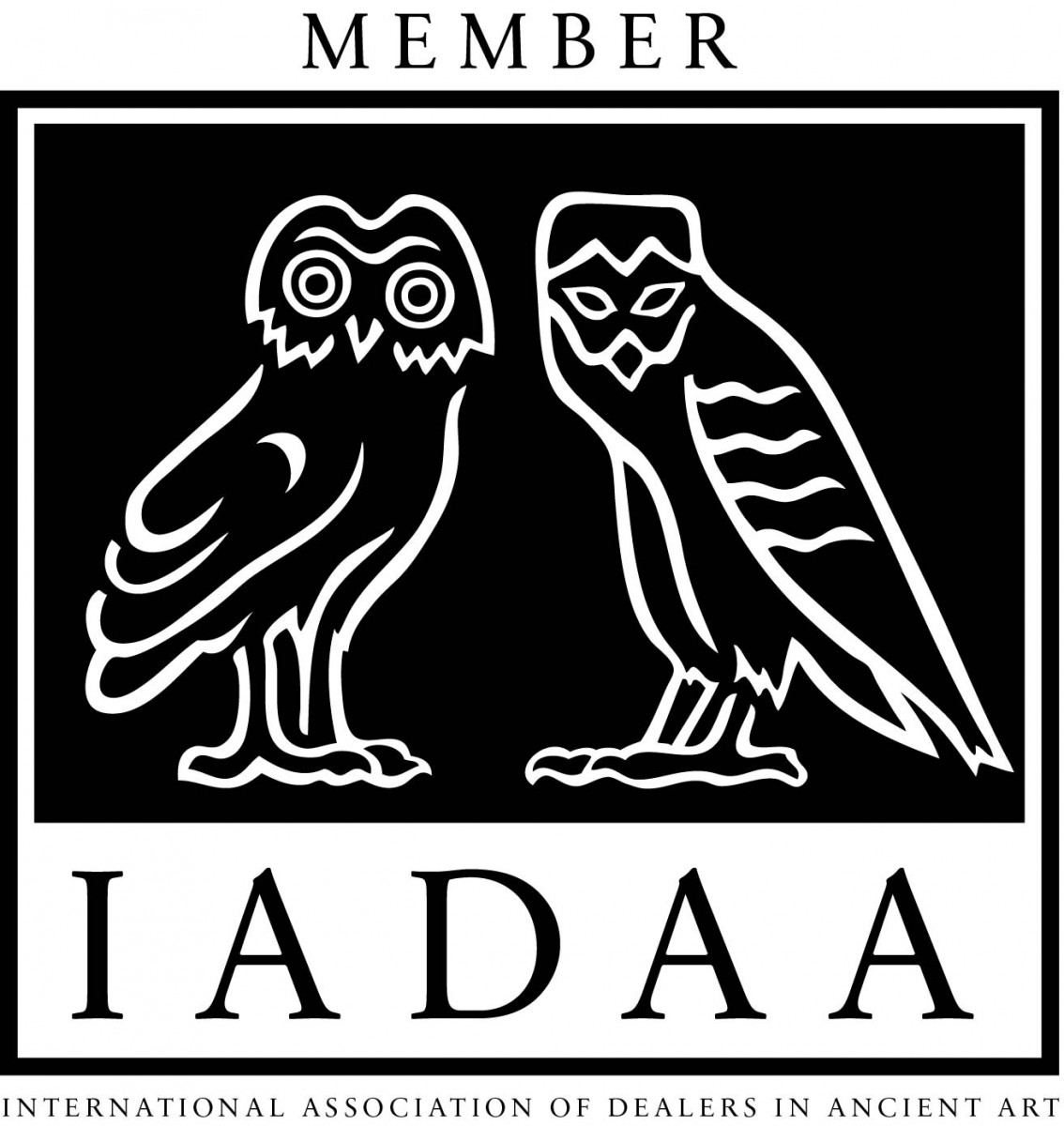
|
|
|
|